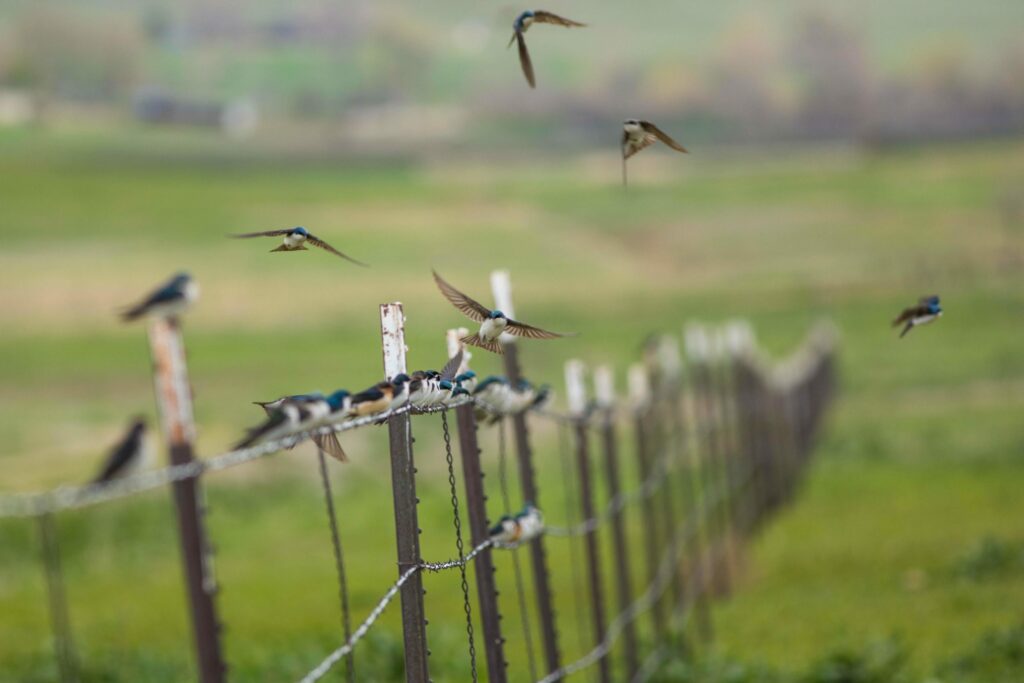Mindful Birding
By Crystal Reser
Denver Audubon Master Birder and Mindful Birding Leader
Just like a growing group of people today, I LOVE Birds! Hiking into a forest; walking a nature trail; visiting a park; reveling in glimpses of feathered friends or hearing a new birdsong; it’s a joy for me and I cherish these moments. The pandemic saw a huge growth in people identifying themselves as birders, and people are spending more time outdoors. It makes sense in today’s world of high stress and anxiety. Studies show that time spent in nature helps us physically and psychologically. But here’s the problem. Our outdoor spaces are being “loved-to-death” and we’re harming birds and their habitats. As conscientious, caring stewards for birds, I propose we take a close look at how, we birders, interact with our natural spaces. I think we can do a better job.
I’ve been on field trips with groups of beginning to expert birders and collectively we’re all making mistakes. In my experience, participants immediately begin talking, waving and pointing, walking off the trail, making lots of noise… you get the picture. It seems folks are there for a social event and not really considering the bird’s perspective. Or, we’re so determined to get a glimpse of a bird we go raging down or off the trail, totally unaware of the habitat. Have you noticed our trails are getting wider and wider?
Let’s consider “pishing” and the use of recorded birdsongs and calls. Playback certainly has a role in scientific research. However, because of the rapid rise in the number of birders the last few years, it is imperative that we employ playback responsibly when we’re out birding. In my opinion, too much playback or phishing in a non-research environment can cause stress to birds and should be limited or completely avoided in the field. Let’s take a closer look at the bird’s perspective and how we can improve.
One of the best books I’ve come across to teach a bird’s perspective is Jon Young’s book, What the Robin Knows. As birders visiting wild spaces, Jon urges us to be more aware of how our actions often cause defensive behaviors in animals. In Jon’s words, we create a zone of disturbance. The book teaches us instead, to create a routine of invisibility. If we are mindful of our own presence and take measures to reduce our impact, we promote animal baseline behavior and ultimately promote their survival. Baseline behaviors allow birds to conserve energy and help them survive day to day. Animal defensive behaviors, however, cause a depletion of energy and threaten a bird’s ability to survive. Defensive behaviors are outside a bird’s normal routine and are a response to threats in their environment. Yes, like those large, loud, gangly groups of humans, strange threatening noises, unwarranted recordings of a territorial call, etc.
Mindful birding and nature awareness practices are the answer! These practices allow us to quiet our busy minds, tap into our senses and feel a deeper connection with nature.
Here’s how I do it. First, set the intention for yourself (or the group if leading others) on a birding walk. Consider the goal of being in nature to see and hear birds and wildlife on their terms. Limiting the number of people in one group is a good first step. Techniques can be as simple as limiting talking, whispering only, and turning off electronics. To help the habitat, watch where you’re placing your feet and stay on the trail. If you must go off trail, step on rocks or carefully maneuver your feet around the vegetation. Walk slowly, with awareness of everything around you. Turn off your thinking brain and really see and hear with your full attention. Look and listen for what’s near you and what’s far away. Notice shapes and colors and textures. Listen for the quietest sound. Stop often. Close your eyes and listen. Sniff the air. Sit down, stay quiet, and see what comes to you. These are all things I do. I’ve had many experiences of birds coming toward me by practicing these techniques. My senses have become sharper and my powers of observation stronger. Ultimately, I feel I’ve become a better birder and a better advocate for birds and nature as a whole.
These simple techniques I’ve described expand our zone of awareness and this zone becomes larger than our zone of disturbance. Birds and other animals will be more apt to stick around and consider us as part of their norm, and we lessen the stress placed on them by our presence. Jon Young states, “the more we adopt a respectful, aware attitude, whether in the yard or the woods or the jungle…the more respectfully we are treated in return”. If we are serious about protecting birds and their habitat, we also must look at our behaviors and our impact, and start paying closer attention. I believe simple mindfulness and nature awareness techniques should be a part of any birder’s practice in the field. It’s good for the birds we love, and good for us too!

